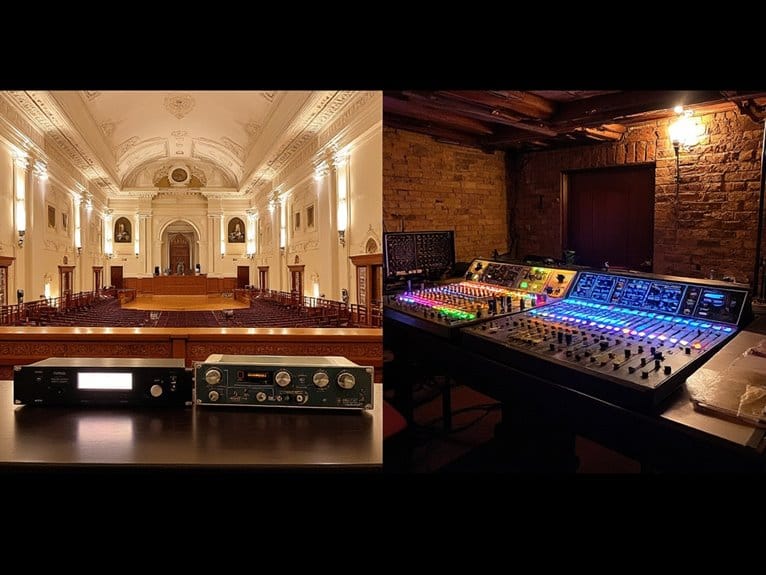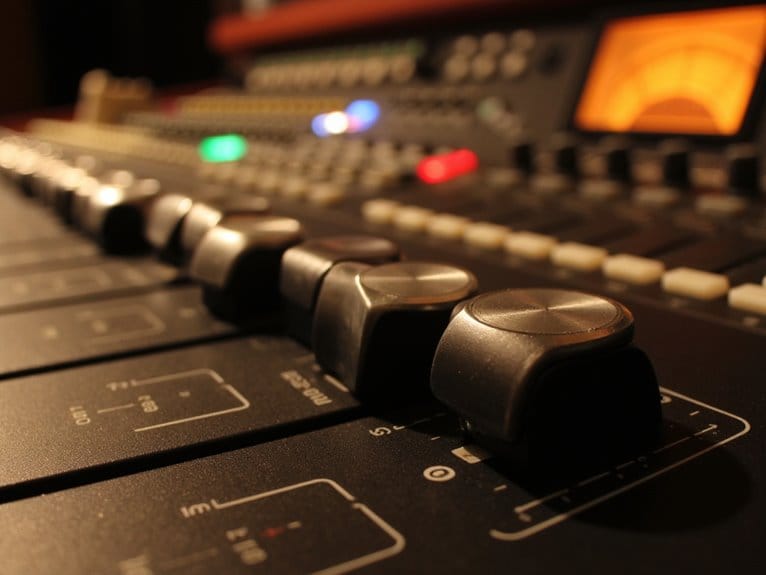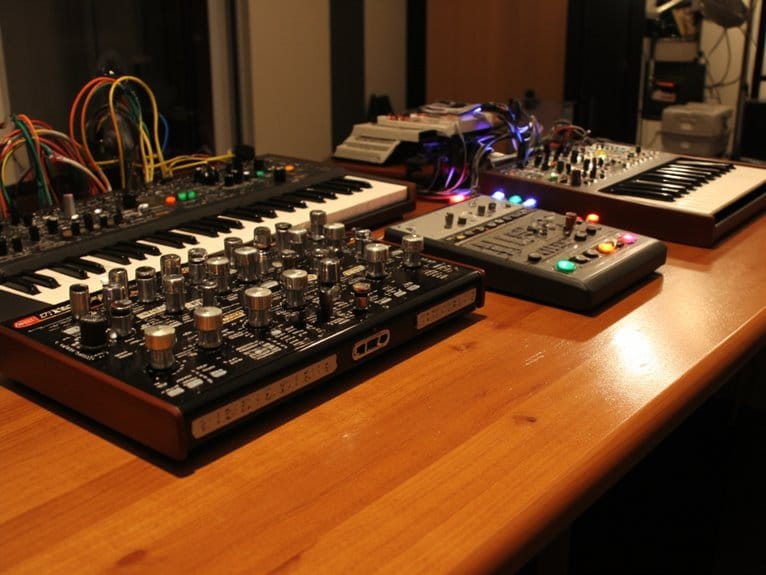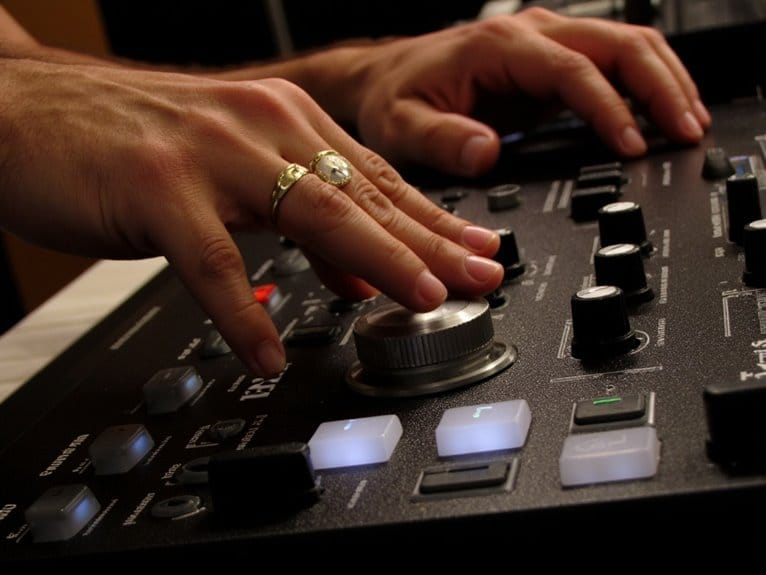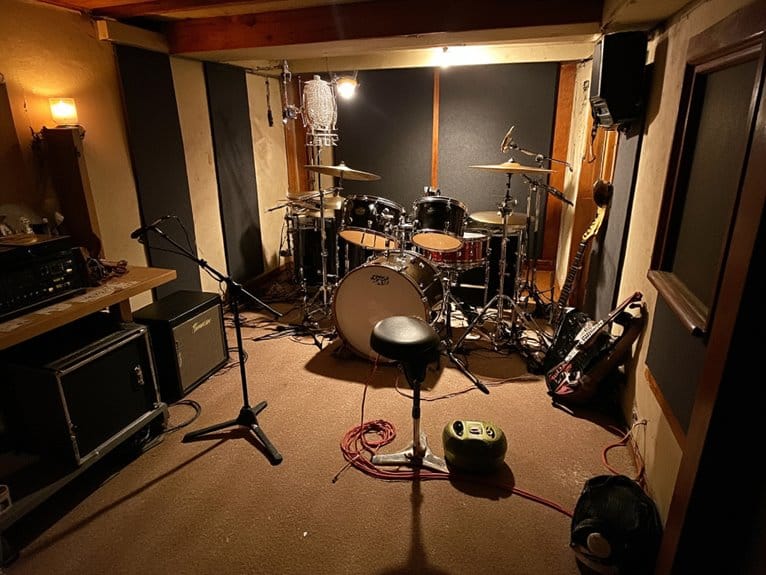Time-Based Effects: Delay and Reverb in Different Genres
Time-based effects shape your mix’s sonic character differently across genres, with the 130-millisecond threshold determining whether delays thicken sound or create distinct echoes. You’ll use slapback delays and plate reverbs for rock warmth, tempo-synced patterns in electronic music, cascading delays for psychedelic immersion, and minimal reverb in hip-hop for clarity. Classical recordings demand hall reverbs with longer decay times to simulate acoustic environments. Understanding these genre-specific applications will reveal advanced mixing techniques that elevate your productions.
We are supported by our audience. When you purchase through links on our site, we may earn an affiliate commission, at no extra cost for you. Learn more.
Notable Insights
- Rock and pop use slapback delay for vocal doubling and plate reverb for warmth and presence.
- Electronic music employs tempo-synced delays and high feedback settings to create rhythmic patterns and movement.
- Psychedelic genres utilize cascading delays and expansive reverbs to build immersive, atmospheric soundscapes.
- Hip-hop relies on short delays for vocal punch while minimizing reverb to maintain clarity and definition.
- Classical music uses hall reverbs with longer decay times to simulate natural acoustic concert environments.
Understanding Reverb and Delay Fundamentals
When you’re mixing audio, understanding how delay and reverb work isn’t just about knowing which knobs to turn-it’s about grasping how these effects fundamentally alter our perception of space and time in ways that can make or break your mix.
Delay timing becomes significant around that 130-millisecond threshold, where shorter delays thicken your sound without creating distinct echoes, while longer delays add rhythmic repetitions that enhance depth perception.
That 130-millisecond delay threshold separates subtle thickening from distinct echoes-mastering this timing is crucial for spatial depth control.
Meanwhile, reverb types like plate, hall, and chamber each simulate different acoustic environments through complex reflection patterns.
I’ve learned that delay feedback controls how many repetitions you’ll hear, and decay time determines how long reverb tails persist, directly affecting your listener’s sense of spatial dimension and room size.
Genre-Specific Applications and Characteristics
Now that you’ve got the technical foundation down, applying these time-based effects becomes a matter of understanding how different musical genres utilize delay and reverb to achieve their signature sounds and emotional characteristics.
In rock and pop, you’ll find slapback delay creating vocal doubles while plate reverbs add warmth without overwhelming the mix.
Electronic music pushes delay techniques further, using tempo-synced patterns and feedback to build complex rhythmic effects that define trance buildups.
Psychedelic genres embrace cascading delays and vast reverb applications to create immersive soundscapes.
Hip-hop keeps things tighter, using short delays for vocal punch while minimizing reverb to maintain clarity.
Classical music relies on hall reverbs with longer decay times, simulating natural acoustic environments where genre variations demand careful calibration to preserve instrumental nuances.
Creative Techniques and Modern Plugin Workflows
While mastering the genre-specific applications gives you the foundation, I’ve found that developing efficient plugin workflows transforms how quickly you can implement creative ideas and maintain momentum during those inspired late-night sessions.
Smart plugin organization by creating custom chains and maintaining favorites lists dramatically reduces search time, while freezing tracks and using send/return channels keeps your CPU happy when layering multiple reverbs and delays.
Modern plugins now feature adaptive processing and multi-mode capabilities that respond dynamically to input levels, which honestly makes my old hardware units feel somewhat antiquated.
I’ll save custom presets organized by mood categories, then build project templates with pre-loaded effect sends, ensuring both sonic clarity and workflow consistency across different creative contexts.
On a final note
You’ve now got the roadmap for wielding delay and reverb across genres, from dub’s echoing valleys to ambient’s infinite spaces. Don’t get trapped thinking there’s only one “right” way-I’ve learned that breaking conventional rules often yields the most compelling results. Your ears remain the final judge, but understanding these foundational approaches gives you the confidence to experiment boldly while respecting each genre’s sonic DNA and listener expectations.

